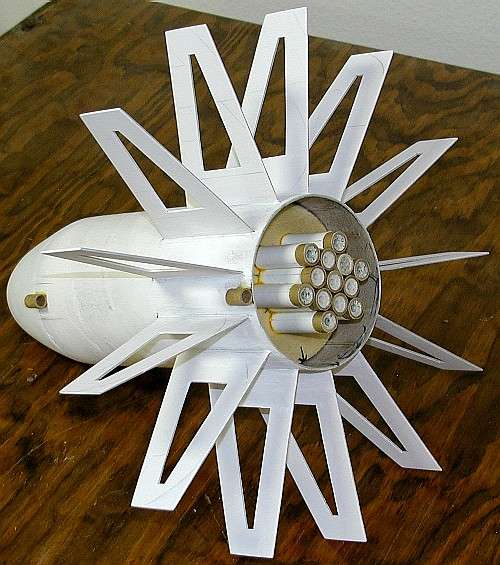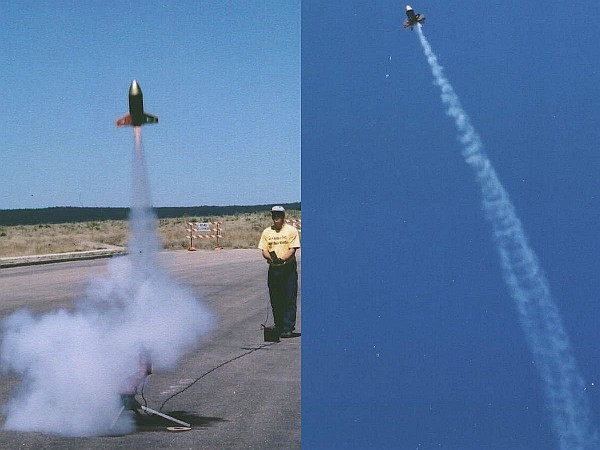Descon TriskaiDESCON Superstitious ThirteenthRoc!
Scratch - TriskaiDESCON Superstitious ThirteenthRoc! {Scratch}
Contributed by David Virga
| Manufacturer: | Scratch |
TriskaiDESCON
Superstitious ThirteenthRoc
by David L. Virga (Black Forest, CO)

Introduction
This rocket is my entry for the thirteenth running of the RMR Design Contest.
As this is the thirteenth DESCON, I decided that a special commemorative rocket
was in order. So, in honor of DESCON XIII, I have designed this rocket with as
many "thirteen" specifications as I could.
What's In A Name?
TriskaiDESCON Superstitious ThirteenthRoc… Quite a mouthful, huh? This is
what it means.
The prefix for thirteen is "triskaideka", as in triskaidekaphobia - the fear of the number thirteen. So, I combined this prefix with the event name, and came up with "TriskaiDESCON", meaning the thirteenth DESCON. The number thirteen is considered by many to be unlucky, and has many superstitions surrounding it. I chose to acknowledge this fact by including the word "Superstitious" in its name.
Finally, since this is a rocket, and since it is celebrating the number thirteen, I combined these two and made "ThirteenthRoc" as the third and final component of its name. Incidentally, all three words have thirteen letters.

Specifications
- Rocket Height: 13 inches
- Body Diameter: 4.138 inches (resulting in a circumference of 13 inches)
- Number of fins: 13
- Fin Span: 13 inches
- Gross Liftoff Weight: 13 ounces
- Number of colors: 13 (Black, White, Gold, Silver, Copper, Pink, Red, Orange,
- Yellow, Green, Blue, Purple, and Brown)
- Propulsion: A cluster of thirteen motors, each 13mm diameter (Seven A3-4T plus six A10-PT for a 65 Newton total impulse E81-4!)
- Recovery: Rear motor pod ejection, with pod and body recovering separately under dual 13-inch parachutes each
Construction Notes
The body tube is a 9" section of thick-wall 4"i.d. carpet tube. I had
to peel, sand, scrape and scratch the outside layers off to achieve the exact
desired outside diameter. Two ½" lengths of ¼" diameter
launch lug are glued to the outside of the body tube. The nose cone is
hand-carved from five stacked slabs of 1" thick blue insulation foam,
shaped into a 1:1 parabola, with a thin layer of finishing epoxy to seal it. It
is glued in place, and also has a thin layer of epoxy on the base surface to
protect it from the motors' ejection blast.
The fins are made from 1/16" 3-ply birch plywood. I had to cut out the centers of the fins to reduce their total weight contribution. I slotted the body tube, and mounted each fin through the wall, flush with the inner surface of the body tube. The adhesive is Titebond II.

Seven ½" motor tubes are glued together, then glued into one end of a 6.5" length of BT-60 body tube. Six additional ½" motor tubes are then glued around the outside of the 7-motor cluster. The lower centering ring sits on top of the six outer motor tubes. The upper centering ring is placed 4 inches above the lower ring. A small hole is drilled near the hub on the upper centering ring; a 12" length of heavy Aramid cord is tied around the BT-60 between the centering rings, and then fed through the hole in the upper ring; the shock cord and parachutes are attached to the end of this cord. The space between the centering rings is covered with manila folder paper, soaked with thin CA for added stiffness.
An 18" length of heavy Aramid cord is tied into a yoke, and the two ends are attached inside the body tube at the base of the nose cone. The body's shock cord and parachutes attach to this yoke. A 1/8" thick ring of kraft paper is glued 5 ½" from the base of the body tube as a thrust ring.

Flight Plans
Rudimentary flight analyses indicate that this rocket will achieve a top speed
of approximately 130mph and an altitude of approximately 300 feet. That is, if
it remains stable and doesn't shed fins under acceleration….
TriskaiDESCON Superstitious ThirteenthRoc's first flight is scheduled for precisely 1:13pm on Tuesday, April 13th, following a 13-second countdown. Stay tuned! One way or another, it is sure to be spectacular!
Flight Report
The flight was a success! Liftoff occurred exactly at 1:13:13pm MDT, Tuesday
April 13th, as timed by a portable radio controlled clock. All 13 motors were
ignited by flashpan; the rocket leaped off of the Mantis pad, exhibited stable
flight in a 5-10mph breeze, and deployed its chutes just past apogee. Dual
13-inch chutes were a bit small for the 7.5oz body section, resulting in a
fixable crimp in the foam nose when it landed on pavement. Otherwise, the
rocket is unscathed!
Thanks to the Pine Creek High School TARC team for their launch assistance, Photos by Nadine for the liftoff and in-flight photos, and Nick for formatting and posting this web page.


Sponsored Ads
 |
 |











